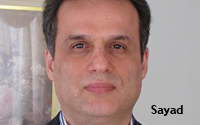Commentary
Real-Time With AdTheorent's Dr. Sayad
- by Tyler Loechner , Staff Writer @mp_tyler, April 1, 2013
 AdTheorent last week released a
white paper about their new real-time learning machine (RTLM), a machine that generates data-driven predictive models
in real-time. AdTheorent and Dr. Saed Sayad, the company's chief data scientist and author of the white paper, believe that real-time predictive models are now a necessity. The RTLM is a patent
pending platform, and AdTheorent claims it is the first "real-time learning and predictive modeling platform developed specifically for mobile advertising." RTM Daily spoke with Sayad about the
process behind creating RTLM, what role the human plays, and what the year 2023 might look like.
AdTheorent last week released a
white paper about their new real-time learning machine (RTLM), a machine that generates data-driven predictive models
in real-time. AdTheorent and Dr. Saed Sayad, the company's chief data scientist and author of the white paper, believe that real-time predictive models are now a necessity. The RTLM is a patent
pending platform, and AdTheorent claims it is the first "real-time learning and predictive modeling platform developed specifically for mobile advertising." RTM Daily spoke with Sayad about the
process behind creating RTLM, what role the human plays, and what the year 2023 might look like.
Sayad tells RTM Daily that 10 years ago, he predicted what the Big Data world would look like today. "I told my friends and our research group, 'We are going to have huge amounts of data, and the existing predictive modeling techniques are not going to work. We need a scalable solution.'" Lo and behold, here we are today with too much data to analyze alone.
The old real-time thinking machine - the human brain - simply isn't capable of taking advantage of this much data as fast as a machine can. Sayad believes that humans have two ways to make decisions, through experience and through data. "99% of [our decisions] are based on experience. Even when we use the data, we still rely on experience," he says. One purpose of the RTLM machine is to balance out the decision-making process to something closer to a 50/50 split.
"The new generation of decision-making is based on experience [and data], but because of the [size and speed] of the data, we need automation," says Sayad. This is why AdTheorent created the RTLM; because it is their belief that the next era of data-driven marketing won't be ushered in without a machine capable of real-time predictive modeling. Sayad thinks that there is “no doubt” that the future of decision-making needs to be a balanced combination of experience and data.
The RTLM is capable of learning and forgetting, adding and deleting variables, testing scenarios, and spitting out predictions in real-time. The human brain cannot do all of that. However, the human doesn't go away, and the reason is one we’ve all heard before.
According to Sayad, RTLM gives "automation which can improve our data processing job, and at the same time give [the humans] time to do what we do best - create something." The RTLM is a big step towards sifting through the noise that is Big Data, but Sayad says, "We should completely forget the machine as superior to human intelligence." Without creativity, the Big Data would be useless. And, as of now, creativity belongs to the humans.
Since Sayad successfully predicted what 2013 would be like 10 year ago (albeit in a self-fulfilled prophecy), it’s natural to want to know what he thinks 10 years from now will look like.
"I like this question," he says. "There's no doubt we are going to have real-time predictive models everywhere." He also predicts that there are going to be cyber agents that can "talk" to each other, likening it to two rovers on Mars sharing knowledge to create a "super knowledge" base. Essentially, when he looks into his crystal ball, he sees an increase in real-time predictive models and an increase in automated communication between machines.
Here's to hoping that in 2023 we aren't hearing about a RTCM (real-time creative machine), or else everyone's favorite (and seemingly only) reason for why the humans are more important than the machines will be gone.



